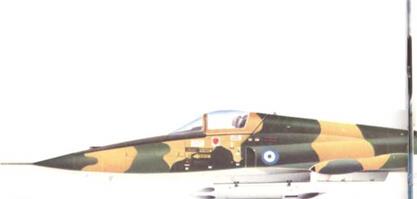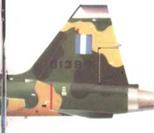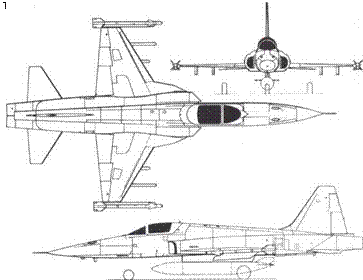Northrop F-5 Freedom Fighter and Tiger II
F-5A, В, E and F, CF-5A and D, NF-5A and B, RF-5A, E and G, and SF-5A and В
Origin: Northrop Aircraft Division, Hawthorne, USA: made or assembled under licence by partnership Canada/Netherlands and by Spain.
Type: (With suffix A, E, and G) single-seat fighter-reconnaissance: (with suffix B, D and F) two-seat dual fighter/trainer.
Engines: (A. B, D, G) two 4,0801b (1850kg) thrust General Electric J85-1 3 single-shaft afterburning turbojets: (E. F) two 5,000lb (2268kg) J85-21. Dimensions: Span (A, B, D, G) 25ft 3in (7-7m): (E. F) 26ft 8in (8-1 3m): length (A, G) 47ft 2in (14-38m): (B, D) 46ft 4in (14-12m): (E) 48ft 3fin (14-73m); (F) 51ft 9Jin (15-80m); height (A, G) 13ft 2in (4-01 m); (B, D)
13ft 1 in (3-99m): (E, F) 13ft 4Jin (4 08m).
Weights: Empty (A, G) 8,085lb (3667kg): (B, D) 8,3611b (3792kg):
(E) 9,5881b (4349kg): (F) 9,7001b (4400kg): maximum loaded (A, G) 20,6771b (9379kg): (B, D) 20,5001b (9298kg): (E, F) 24,0801b (10,922kg). Performance: Maximum speed at altitude (A, G) 925mph (1489km/h,
Mach 1 -40): (B, D) 885mph (1424km/h, Mach 1-34); (E) 1,060mph (1705km/h. Mach 1 -60); initial climb (A, G) 28,700ft (8760m)/min; (B, D) 30,400ft (9265m)/min; (E) 31,600ft (9630m)/min; service ceiling (A, G) 50,500ft (15,390m): (B, D) 52,000ft (15,850m): (E) 54.000ft (16,460m); range with max fuel, with reserves, tanks retained, (A, G) 1,387 miles (2232km); (B, D) 1,393 miles (2241km); (E) 1,974 miles (3175km).
Armament: Two 20mm M-39A2 cannon each with 280 rounds in nose (can be retained in RF versions); five pylons for total external load of about 4,400lb (2000kg) in A, G (total military load for these models, including guns and ammunition, is 5.200lb) or 7,000lb (3175kg) in E; rails on wing – tips for AIM-9 Sidewinder missiles. (
History: First flight (XT-38) 10 April 1959. (N-156F) 30July1959. (F-5A)
19 May 1964, (F-5E) 11 August 1972, (F-5F) 25 September 1974.
Users: (A, B, D, G) Brazil, Canada, Ethiopia, Greece, Iran, Jordan, S Korea,
Libya, Malaysia, Morocco, Netherlands, Norway, Pakistan, Philippines,
Saudi Arabia, Spain, Taiwan, Thailand, Turkey, USA (Air Force, not operational); (E, F) Brazil, Chile, Egypt, Ethiopia, Indonesia, Iran, Jordan,
Kenya, Malaysia, Morocco, Peru, Philippines, Saudi Arabia, Singapore,
S Korea, Sudan, Switzerland, Taiwan, Thailand. Tunisia, USA (Air Force,
Navy), Vietnam (probably not operational).
 Development: In 1 955 Northrop began the project design of a lightweight fighter, known as Tally-Ho, powered by two J85 missile engines slung in pods under a very small unswept wing. It was yet another of the many projects born in the Korean era when pilots were calling for lighter, simpler fighters with higher performance. Gradually Welko Gasich and his team refined the design, putting the engines in the fuselage and increasing the size, partly to meet the needs of the Navy. In June 1956 the Navy had pulled out, while the Air Force ordered the trainer version as the T-38
Development: In 1 955 Northrop began the project design of a lightweight fighter, known as Tally-Ho, powered by two J85 missile engines slung in pods under a very small unswept wing. It was yet another of the many projects born in the Korean era when pilots were calling for lighter, simpler fighters with higher performance. Gradually Welko Gasich and his team refined the design, putting the engines in the fuselage and increasing the size, partly to meet the needs of the Navy. In June 1956 the Navy had pulled out, while the Air Force ordered the trainer version as the T-38
Talon. Over the next 15 years Northrop delivered 1,200 Talons, all to the USAF or NASA, as the standard supersonic trainer of those services. With this assured programme the company took the unique decision to go ahead and build a demonstration fighter in the absence of any orders – the only time this has ever been done with a supersonic aircraft. By the time it was ready for flight in 1959 the N-156F, dubbed Freedom Fighter had received some US Defense funding, and the prototype carried US serial and stencil markings but no national markings. It was a simple little fighter, carrying about 485 gallons of fuel, two cannon and an old F-86 style sight, and having racks for two little Sidewinder missiles. Today such a prototype would have remained unsold, but in October 1962 the Department of Defense decided to buy the so-called Freedom Fighter in large numbers to give, or sell on advantageous terms, to anti-Communist nations. More than 1,040 of the Freedom Fighter (suffixes A, B, D, G) have been built, all but 178 being exports from Northrop. The Netherlands built the NF-5A and В equipment, heavier mission load, 500lb (227kg) more fuel in the longer fuselage, new inlet ducts, revised body and wing, root extensions and manoeuvring flaps and an X-band radar. Deliveries began in 1972, followed by the two-seat F In 1975. The US Air Force uses the Tiger II to equip its Tac Ftr Training Aggressor units, simulating hostile aircraft; the US Navy uses it as an Air Combat Trainer for future F-4 or F 14 pilots. Basic price of an E is considerably higher than that of the more powerful Jaguar (a recent sale was 12 for Kenya, priced at $706 million), but over 1,000 of the Tiger II type are likely to be supplied on attractive terms to many countries.

 |
Left: An F-5A Freedom Fighter of the Hellenic (Greek) air force. These rather limited aircraft equip the 349a Mira at Larissa and the 337а, 341a and 343s all based at Nea Ankhialos near Volos. They have the advantage of good weather, vital for aircraft in this category.










